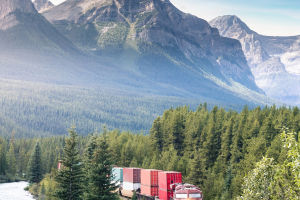Train tracks around a mountain can be a fascinating feat of engineering. It is an ambitious and challenging project that requires a thorough understanding of the terrain, the environment, and the limitations of the technology being used.
A train track around a mountain can offer stunning views and provide access to areas that may be difficult to reach by road or foot. In this article, we will explore the details of building train tracks around a mountain.
The first step in building a train track around a mountain is to perform a detailed terrain analysis. The analysis includes studying the geography, topography, and geology of the area to determine the best possible route for the train track.
The route planning considers several factors such as the gradients, curves, and elevation changes required to build a track. The terrain and environmental conditions can pose significant challenges to the construction of a track. Therefore, engineers must carefully plan the route to minimize any adverse impacts on the surrounding environment.
Once the route has been planned, the next step is to start the construction of the track. The process involves several stages, including the excavation of the land, laying the tracks, and installing the necessary infrastructure.
The excavation of the land involves creating the path on which the track will be laid. This process can involve the use of explosives, bulldozers, and other heavy equipment to remove large amounts of rock and earth.
The track-laying process involves placing the rails on the prepared path and connecting them with bolts and screws. This process requires a high degree of precision to ensure that the rails are straight and level. Any deviation from the correct alignment can result in derailments, which can be dangerous and costly.
The installation of the infrastructure is another critical stage in the construction of train tracks around a mountain. The infrastructure includes bridges, tunnels, retaining walls, and other support structures necessary to maintain the stability of the track.
Bridges and tunnels are constructed to enable the train track to traverse obstacles such as rivers, valleys, and cliffs. Retaining walls are built to stabilize the slope of the mountain and prevent landslides or rockfalls from damaging the track.
The safety of passengers and workers is paramount in the construction and operation of train tracks around a mountain. Engineers and construction workers must follow strict safety protocols to prevent accidents and injuries.
The construction of a train track around a mountain requires the use of heavy machinery, explosives, and other hazardous materials. Therefore, safety measures such as personal protective equipment, hazard signage, and safety barriers must be in place to prevent accidents.
During operation, the train track must be inspected regularly to ensure that it is in good condition and safe for use. Any faults or damage must be repaired promptly to prevent accidents.
Building train tracks around a mountain is a complex and challenging project that requires a high degree of expertise, planning, and coordination. The project involves several stages, including terrain analysis, route planning, track construction, infrastructure installation, and safety measures.
Train tracks around a mountain can provide access to remote areas, offer stunning views, and improve transportation and connectivity in the region. However, the project must be approached with caution and consideration for the environment and safety of workers and passengers.
The construction of train tracks around a mountain is a remarkable engineering achievement that requires skill, patience, and dedication. With careful planning and execution, it is possible to build a train track that not only provides transportation but also enhances the natural beauty of the surrounding area.


